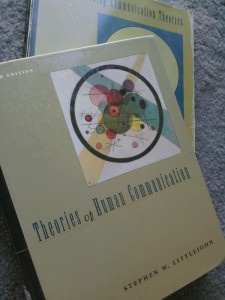I used to start my first lecture of the semester for university students with the words one cannot not communicate. The phrase came from the Palo Alto Group, a group of researchers studying the mind.
The basic idea is that no matter what we’re doing or saying, we are indeed communicating something to the other person. That’s why it irks me to no end when I hear someone say, “we’re not communicating.” Because it’s not that someone isn’t communicating, it’s that he or she isn’t communicating effectively.
If you’re sitting on a bus reading a book with the cover “50 Shades of Grey”, you’re communicating something different to other riders than if you’re reading a book with the cover “The Bible.” If you’re silent during a lunch out with your best friend, you’re communicating something to him or her.
 The challenging, complicated, and fun part (to me) is recognizing the interpretation of the messages you’re sending depend on who’s receiving them. People are going to interpret what you’re sending differently depending on their own backgrounds or communication styles and especially because of their relationship with you.
The challenging, complicated, and fun part (to me) is recognizing the interpretation of the messages you’re sending depend on who’s receiving them. People are going to interpret what you’re sending differently depending on their own backgrounds or communication styles and especially because of their relationship with you.
Relationships are an important theme in the study of interpersonal communication. A relationship is a set of expectations two people have for their behavior based on the pattern of interaction between them.
One relationship-related theory that fascinates me is Uncertainty Reduction Theory. That asserts people have a need to reduce uncertainty about others by gaining information about them.
Information gained can then be used to predict the others’ behavior. Reducing uncertainty is particularly important in relationship development, so it’s typical to find more uncertainty reduction behavior among people when they expect or want to develop a relationship than among people who expect or know they will not develop a relationship.
There are exceptions naturally, and that’s when communication on a first date, for example, can be tricky. The rule of thumb is to know that in every situation, you are basically creating some type of relationship, even if it lasts the two hours at the coffee shop and then you sip and go.
But overall the need to know more about a person is heightened when we expect to have future encounters, especially rewarding or costly ones, with the individual.
There are three basic ways people seek information about another person:
- Passive strategies — observing the person, either in situations where the other person is likely to be a little more guarded like at a workplace or in a classroom, or where the other person is likely to act more naturally like in the stands at a football game.
- Active strategies — asking others about the person we’re interested in or trying to set up a situation where we can observe that person (e.g., taking the same class, sitting a table away at dinner, organizing a pickup basketball game). Once the situation is set up we observe the person
- Interactive strategies — we communicate directly with the person.
Just remember, one cannot not communicate.
Source: Littlejohn, Stephen W. “Communication in Relationships.” Theories of Human Communication. Belmont, CA: Wadsworth Publishing Company, 1999. 252-282.

Love your blog Sip and Go Girl! Know I burn many minutes rocking my boy & reading it instead of doing laundry or dishes or some other task I hate!
I love your blog Sip and Go Girl! Reminds me of my own romantic encounters many years ago!!
😉
nice
<3